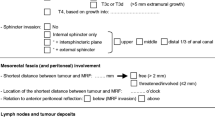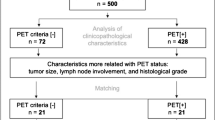Abstract
Purpose
To evaluate the potential of [18F]fluorodeoxyglucose positron emission tomography (FDG-PET) for the assessment of histopathological response and survival after neoadjuvant radiochemotherapy in patients with oesophageal cancer.
Patients and methods
In 2005 and 2006, 55 patients (43 men, 12 women; median age 60 years) with locally advanced oesophageal cancer (cT3-4 Nx M0; 24 with squamous cell carcinoma, 31 with adenocarcinoma) underwent transthoracic en bloc oesophagectomy after completion of treatment with cisplatin, 5-fluorouracil, and radiotherapy ad 36 Gy in a prospective clinical trial. Of the 55 patients, 21 (38%) were classified as histopathological responders (<10% vital residual tumour cells) and 34 (62%) as nonresponders. FDG-PET was performed before (PET 1) and 3–4 weeks after the end (PET 2) of radiochemotherapy with assessment of maximum and average standardized uptake values (SUV) for correlation with histopathological response and survival.
Results
Histopathological responders had a slightly higher baseline SUV than nonresponders (p<0.0001 between PET 1 and PET 2 for responders and nonresponders) and the decrease was more prominent in responders. Except for SUVmax in patients with squamous cell carcinoma neither baseline nor preoperative SUV nor percent SUV reduction correlated significantly with histopathological response. Histopathological responders had a 2-year overall survival of 91 ± 9% and nonresponders a survival of 53 ± 10% (p = 0.007).
Conclusion
Our study does not support recent reports that FDG-PET predicts histopathological response and survival in patients with locally advanced oesophageal cancer treated by neoadjuvant radiochemotherapy.



Similar content being viewed by others
References
Enzinger PC, Mayer RJ. Esophageal cancer. N Engl J Med 2003;349:2241–52.
Ando N, Ozawa S, Kitagawa Y, Shinozawa Y, Kitajima M. Improvement in the results of surgical treatment of advanced squamous esophageal carcinoma during 15 consecutive years. Ann Surg 2000;232:225–32.
Whooley BP, Law S, Murthy SC, Alexandrou A, Wong J. Analysis of reduced death and complication rates after esophageal resection. Ann Surg 2001;233:338–44.
Refaely Y, Krasna MJ. Multimodality therapy for esophageal cancer. Surg Clin North Am 2002;82:729–46.
Thomas CR Jr. Current and ongoing progress in the therapy for resectable esophageal cancer. Dis Esophagus 2005;18:211–4.
Medical Research Council Oesophageal Cancer Working Party. Surgical resection with or without preoperative chemotherapy in oesophageal cancer: a randomised controlled trial. Lancet 2002;359:1727–33.
Urba SG, Orringer MB, Turrisi A, Iannettoni M, Forastiere A, Strawderman M. Randomized trial of preoperative chemoradiation versus surgery alone in patients with locoregional esophageal carcinoma. J Clin Oncol 2001;19:305–13.
Urschel JD, Vasan H, Blewett CJ. A meta-analysis of randomized controlled trials that compared neoadjuvant chemotherapy and surgery to surgery alone for resectable esophageal cancer. Am J Surg 2002;183:274–9.
Bombardieri E. The added value of metabolic imaging with FDG-PET in oesophageal cancer: prognostic role and prediction of response to treatment. Eur J Nucl Med Mol Imaging 2006;33:753–8.
Skehan SJ, Brown AL, Thompson M, Young JEM, Coates G, Nahmias C. Imaging features of primary and recurrent esophageal cancer at FDG PET. Radiographics 2000;20:713–23.
Walsh TN, Noonan N, Hollywood D, Kelly A, Keeling N, Hennessy TP. A comparison of multimodal therapy and surgery for esophageal adenocarcinoma. N Engl J Med 1996;335:462–7.
Rouvelas I, Zeng W, Lindblad M, Viklund P, Ye W, Lagergren J. Survival after neoadjuvant therapy compared with surgery alone for resectable esophageal cancer in a population-based study. World J Surg 2006;30:2182–90.
Siewert JR, Lordick F, Ott K, Stein HJ, Weber WA, Becker K, et al. Induction chemotherapy in Barrett cancer. Influence on surgical risk and outcome. Ann Surg 2007;246:624–31.
Darnton SJ, Archer VR, Stocken DD, Mulholland PJ, Casson AG, Ferry DR. Preoperative mitomycin, ifosfamide, and cisplatin followed by esophagectomy in squamous cell carcinoma of the esophagus: pathologic complete response induced by chemotherapy leads to long-term survival. J Clin Oncol 2003;21:4009–15.
Swisher SG, Hofstetter W, Wu TT, Correa AM, Ajani JA, Komaki RR, et al. Proposed revision of the esophageal cancer staging system to accommodate pathologic response (pP) following preoperative chemoradiation (CRT). Ann Surg 2005;241:810–20.
Schneider PM, Baldus SE, Metzger R, Kocher M, Bongartz R, Bollschweiler E, et al. Histomorphologic tumor regression and lymph node metastases determine prognosis following neoadjuvant radiochemotherapy for esophageal cancer: implications for response classification. Ann Surg 2005;242:684–92.
Weber WA, Ott K, Becker K, Dittler H-J, Helmberger H, Avril NE, et al. Prediction of response to preoperative chemotherapy in adenocarcinomas of the esophagogastric junction by metabolic imaging. J Clin Oncol 2001;19:3058–65.
Downey RJ, Akhurst T, Ilson D, Ginsberg R, Bains MS, Gonen M, et al. Whole body 18FDG-PET and the response of esophageal cancer to induction therapy: results of a prospective trial. J Clin Oncol 2003;21:428–32.
Swisher SG, Erasmus J, Maish M, Correa AM, Macapinlac H, Ajani JA, et al. 2-Fluoro-2-deoxy-D-glucose positron emission tomography imaging is predictive of pathologic response and survival after preoperative chemoradiation in patients with esophageal carcinoma. Cancer 2004;101:1776–85.
Wieder HA, Brücher BLDM, Zimmermann F, Becker K, Lordick F, Beer A, et al. Time course of tumor metabolic activity during chemoradiotherapy of esophageal squamous cell carcinoma and response to treatment. J Clin Oncol 2004;22:900–8.
Duong CP, Hicks RJ, Weih L, Drummond E, Leong T, Michael M, et al. FDG-PET status following chemoradiotherapy provides high management impact and powerful prognostic stratification in oesophageal cancer. Eur J Nucl Med Mol Imaging 2006;33:770–8.
Levine EA, Farmer MR, Clark P, Mishra G, Ho C, Geisinger KR, et al. Predictive value of 18-fluoro-deoxy-glucose-positron emission tomography (18F-FDG-PET) in the identification of responders to chemoradiation therapy for the treatment of locally advanced esophageal cancer. Ann Surg 2006;243:472–8.
Ott K, Weber WA, Lordick F, Becker K, Busch R, Herrmann K, et al. Metabolic imaging predicts response, survival, and recurrence in adenocarcinomas of the esophagastric junction. J Clin Oncol 2006;24:4692–8.
Lordick F, Ott K, Krause BJ, Weber WA, Becker K, Stein HJ, et al. PET to assess early metabolic response and guide treatment of adenocarcinoma of the oesophagogastric junction: the MUNICON phase II trial. Lancet Oncol 2007;8:797–805.
Wieder HA, Ott K, Lordick F, Becker K, Stahl A, Herrmann K, et al. Prediction of tumor response by FDG-PET: comparison of the accuracy of single and sequential studies in patients with adenocarcinomas of the esophagogastric junction. Eur J Nucl Med Mol Imaging 2007;34:1925–32.
Gillham CM, Lucey JA, Keogan M, Duffy GJ, Malik V, Raouf AA, et al. 18FDG uptake during induction chemoradiation for oesophageal cancer fails to predict histomorphological tumour response. Br J Cancer 2006;95:1174–9.
Smithers BM, Couper GC, Thomas JM, Wong D, Gotley DC, Martin I, et al. Positron emission tomography and pathological evidence of response to neoadjuvant therapy in adenocarcinoma of the esophagus. Dis Esophagus 2008;21:151–8.
Schröder W, Bollschweiler E, Kossow C, Hölscher AH. Preoperative risk analysis – a reliable predictor of postoperative outcome after transthoracic esophagectomy? Langenbecks Arch Surg 2006;391:455–60.
Hölscher AH, Schröder W, Bollschweiler E, Beckurts KT, Schneider PM. How safe is high intrathoracic esophagogastrostomy? Chirurg 2003;74:726–33.
Hölscher AH, Schneider PM, Gutschow C, Schröder W. Laparoscopic ischemic conditioning of the stomach for esophageal replacement. Ann Surg 2007;245:241–6.
Baldus SE, Mönig SP, Schröder W, Metzger R, Lang S, Zirbes TK, et al. Regression of oesophageal carcinomas after neoadjuvant radiochemotherapy: criteria of the histopathological evaluation. Pathologe 2004;25:421–7.
Bollschweiler E. Benefits and limitations of Kaplan-Meier calculations of survival chance in cancer surgery. Langenbecks Arch Surg 2003;388:239–44.
Cunningham D, Allum WH, Stenning SP, Thompson JN, Van de Velde CJ, Nicolson M, et al.; MAGIC Trial Participants. Perioperative chemotherapy versus surgery alone for resectable gastroesophageal cancer. N Engl J Med 2006;355:11–20.
Gebski V, Burmeister B, Smithers BM, Foo K, Zalcberg J, Simes J; Australasian Gastro-Intestinal Trials Group. Survival benefits from neoadjuvant chemoradiotherapy or chemotherapy in oesophageal carcinoma: a meta-analysis. Lancet Oncol 2007;8:226–34.
Bollschweiler E, Hölscher AH. Prediction of tumour response by FDG-PET in patients with adenocarcinomas of the oesophagogastric junction. Eur J Nucl Med Mol Imaging 2008;35:1742–3.
Higashi K, Clavo AC, Wahl RL. In vitro assessment of 2-fluoro-2-deoxy-D-glucose, L-methionine and thymidine as agents to monitor the early response of a human adenocarcinoma cell line to radiotherapy. J Nucl Med 1993;34:773–9.
Nordén MM, Larsson F, Tedelind S, Carlsson T, Lundh C, Forssell-Aronsson E, et al. Down-regulation of the sodium/iodide symporter explains 131I-induced thyroid stunning. Cancer Res 2007;67:7512–7.
Meller B, Gaspar E, Deisting W, Czarnocka B, Baehre M, Wenzel BE. Decreased radioiodine uptake of FRTL-5 cells after (131)I incubation in vitro: molecular biological investigations indicate a cell cycle-dependent pathway. Eur J Nucl Med Mol Imaging 2008;35:1204–12.
Weber WA. Use of PET for monitoring cancer therapy and for predicting outcome. J Nucl Med 2005;46:983–95.
Hawkins RA, Choi Y, Huang SC, Messa C, Hoh CK, Phelps ME. Quantitating tumor glucose metabolism with FDG and PET. J Nucl Med 1992;33:339–44.
Keyes JW Jr. SUV: standard uptake or silly useless value ? J Nucl Med 1995;36:1836–9.
Soret M, Bacharach SL, Buvat I. Partial-volume effect in PET tumor imaging. J Nucl Med 2007;48:932–45.
Sugawara Y, Zasadny KR, Neuhoff AW, Wahl RL. Reevaluation of the standardized uptake value for FDG: variations with body weight and methods for correction. Radiology 1999;213:521–5.
Huang SC. Anatomy of SUV. Standardized uptake value. Nucl Med Biol 2000;27:643–6.
Brink I, Klenzner Th, Krause Th, Mix M, Ross UH, Moser E, et al. Lymph node staging in extracranial head and neck cancer with FDG PET – appropriate uptake period and size-dependence of the results. Nuklearmedizin 2002;41:108–13.
Stahl A, Ott K, Schwaiger M, Weber WA. Comparison of different SUV-based methods for monitoring cytotoxic therapy with FDG PET. Eur J Nucl Med Mol Imaging 2004;31:1471–9.
Author information
Authors and Affiliations
Corresponding author
Additional information
An erratum to this article can be found at http://dx.doi.org/10.1007/s00259-009-1087-z
Rights and permissions
About this article
Cite this article
Schmidt, M., Bollschweiler, E., Dietlein, M. et al. Mean and maximum standardized uptake values in [18F]FDG-PET for assessment of histopathological response in oesophageal squamous cell carcinoma or adenocarcinoma after radiochemotherapy. Eur J Nucl Med Mol Imaging 36, 735–744 (2009). https://doi.org/10.1007/s00259-008-1011-y
Received:
Accepted:
Published:
Issue Date:
DOI: https://doi.org/10.1007/s00259-008-1011-y




